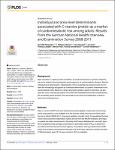Individual and area-level determinants associated with C-reactive protein as a marker of cardiometabolic risk among adults: Results from the German National Health Interview and Examination Survey 2008-2011
Steppuhn, Henriette
Laußmann, Detlef
Baumert, Jens
Kroll, Lars
Lampert, Thomas
Plaß, Dietrich
Scheidt-Nave, Christa
Heidemann, Christin
Background
High-sensitivity C-reactive protein (hsCRP) is a sensitive biomarker of systemic inflammation and is related to the development and progression of cardiometabolic diseases. Beyond individual-level determinants, characteristics of the residential physical and social environment are increasingly recognized as contextual determinants of systemic inflammation and cardiometabolic risks. Based on a large nationwide sample of adults in Germany, we analyzed the cross-sectional association of hsCRP with residential environment characteristics. We specifically asked whether these associations are observed independent of determinants at the individual level.
Methods
Data on serum hsCRP levels and individual sociodemographic, behavioral, and anthropometric characteristics were available from the German Health Interview and Examination Survey for Adults (2008–2011). Area-level variables included, firstly, the predefined German Index of Socioeconomic Deprivation (GISD) derived from the INKAR (indicators and maps on spatial and urban development in Germany and Europe) database and, secondly, population-weighted annual average concentration of particulate matter (PM10) in ambient air provided by the German Environment Agency. Associations with log-transformed hsCRP levels were analyzed using random-intercept multi-level linear regression models including 6,768 participants aged 18–79 years nested in 162 municipalities.
Results
No statistically significant association of PM10 exposure with hsCRP was observed. However, adults residing in municipalities with high compared to those with low social deprivation showed significantly elevated hsCRP levels (change in geometric mean 13.5%, 95%CI 3.2%-24.7%) after adjusting for age and sex. The observed relationship was independent of individual-level educational status. Further adjustment for smoking, sports activity, and abdominal obesity appeared to markedly reduce the association between area-level social deprivation and hsCRP, whereas all individual-level variables contributed significantly to the model.
Conclusions
Area-level social deprivation is associated with higher systemic inflammation and the potentially mediating role of modifiable risk factors needs further elucidation. Identifying and assessing the source-specific harmful components of ambient air pollution in population-based studies remains challenging.

